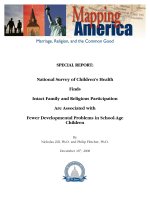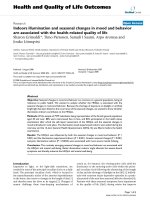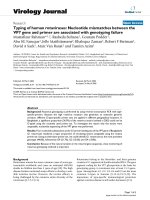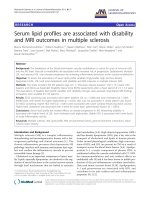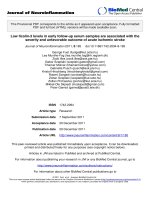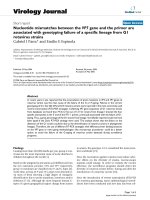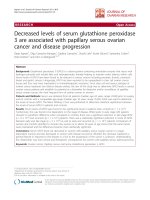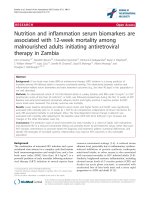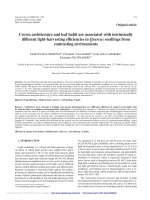Febrile illness and pro-inflammatory cytokines are associated with lower neurodevelopmental scores in Bangladeshi infants living in poverty
Bạn đang xem bản rút gọn của tài liệu. Xem và tải ngay bản đầy đủ của tài liệu tại đây (655.86 KB, 9 trang )
Jiang et al. BMC Pediatrics 2014, 14:50
/>
RESEARCH ARTICLE
Open Access
Febrile illness and pro-inflammatory cytokines are
associated with lower neurodevelopmental scores
in Bangladeshi infants living in poverty
Nona M Jiang1, Fahmida Tofail2, Shannon N Moonah1, Rebecca J Scharf1,3, Mami Taniuchi1, Jennie Z Ma4,
Jena D Hamadani2, Emily S Gurley2, Eric R Houpt1, Eduardo Azziz-Baumgartner5, Rashidul Haque2
and William A Petri Jr1*
Abstract
Background: An estimated one-third of children younger than 5 years in low- and middle-income countries fail to
meet their full developmental potential. The first year of life is a period of critical brain development and is also
when most of the morbidity from infection is suffered. We aimed to determine if clinical and biological markers of
inflammation in the first year of life predict cognitive, language, and motor outcomes in children living in an urban
slum in Bangladesh.
Methods: Children living in Dhaka, Bangladesh were observed from birth until 24 months of age. Febrile illness was
used as a clinical marker of inflammation and elevated concentrations of inflammation-related cytokines (IL-1β, IL-6,
TNF-α, IL-4, IL-10) in sera collected from a subset of the cohort (N = 127) at 6 months of age were used as
biomarkers of inflammation. Psychologists assessed cognitive, language, and motor development using a culturally
adapted version of the Bayley Scales of Infant and Toddler Development, Third Edition (Bayley-III) at 12 (N = 398)
and 24 months of age (N = 210). We tested for the ability of febrile illness and elevated cytokine levels to predict
developmental outcomes, independent of known predictors of stunting, family income, and maternal education.
Results: Every additional 10 days of fever was associated with a 1.9 decrease in language composite score and a
2.1 decrease in motor composite score (p = 0.005 and 0.0002, respectively). Elevated levels of the pro-inflammatory
cytokines IL-1β (> 7.06 pg/mL) and IL-6 (> 10.52 pg/mL) were significantly associated with a 4.9 and 4.3 decrease in
motor score, respectively. Conversely, an elevated level of the Th-2 cytokine IL-4 (> 0.70 pg/mL) was associated with
a 3.6 increase in cognitive score (all p < 0.05).
Conclusions: Clinical and biological markers of inflammation in the first year of life were significantly associated
with poor neurodevelopmental outcomes. Conversely, a Th2-like response was associated with a better outcome.
These findings suggest that markers of inflammation could serve as prognostic indicators and potentially lead to
immune-based therapies to prevent developmental delays in at-risk children.
Keywords: IL-1β, IL-6, IL-4, Child development, Cognition, Fever, Inflammation, Motor, Neurodevelopment,
Pro-inflammatory
* Correspondence:
1
Division of Infectious Diseases and International Health, Department of
Medicine, University of Virginia School of Medicine, PO Box 801340,
Charlottesville, VA 22908, USA
Full list of author information is available at the end of the article
© 2014 Jiang et al.; licensee BioMed Central Ltd. This is an Open Access article distributed under the terms of the Creative
Commons Attribution License ( which permits unrestricted use, distribution, and
reproduction in any medium, provided the original work is properly credited. The Creative Commons Public Domain
Dedication waiver ( applies to the data made available in this article,
unless otherwise stated.
Jiang et al. BMC Pediatrics 2014, 14:50
/>
Background
An estimated one-third of the world’s children younger
than 5 years fail to meet their full developmental potential, increasing the risk that poor health and poverty
will follow these disadvantaged children into adulthood, thereby perpetuating the vicious cycles of poverty and impaired development [1,2]. The first year of
life is a period of critical and rapid brain development
and is also when most of the morbidity and mortality
from infection is suffered [1,3]. Recurrent infection in
early childhood contributes to stunted growth and development [3,4]. While stunting has been associated
with cognitive impairment, mechanisms that result in
cerebral damage are not fully understood. It remains
controversial whether infection has an independent effect on neurodevelopment through mechanisms such as
chronic inflammation [5-7].
The developing brain appears to be particularly vulnerable to inflammatory damage [8]. Infection and inflammation at or near the time of birth have been
linked to neurodevelopmental impairments in preterm
infants [9-11]. In experimental models, inflammatory
cytokines were found to partially mediate inflammationinduced brain damage [9]. Several studies in preterm
infants have shown associations of elevated levels of
inflammation-related proteins near the time of birth
with cognitive dysfunctions years later [12-14]. To the
best of our knowledge, no studies have linked markers
of inflammation during the post-neonatal period to
child development.
Children living in poverty, who suffer disproportionately from chronic and recurrent infections during early
childhood, may be at high risk for inflammation-related
brain injury. While pneumonia and diarrhea are among
the leading causes of infection in children of the developing world, these children also bear a high burden of
helminth infections [15,16]. Helminth infections induce
a Th-2 immune response in the host, which is characterized by the production of cytokines such as IL-4 [17,18].
The effect of helminth infection on cognitive function in
children has been studied, but results across studies are
inconsistent and often conflicting [16,19].
We aimed to test whether specific markers of inflammation are associated with developmental outcomes in
children. Early identification of at-risk children would
allow for the implementation of early and targeted interventions. We hypothesized that both clinical and
biological markers of inflammation during the first year
of life would be associated with later developmental
outcomes. We used febrile illness as a clinical marker
of inflammation and the endogenous pyrogens IL-1β,
IL-6, and TNF-α as biological markers of inflammation.
Additionally, we used IL-4 as a marker of a Th2-like
immune response.
Page 2 of 9
Methods
Study population and enrollment
This longitudinal study was conducted on a cohort of
children living in an urban slum of Mirpur in Dhaka,
Bangladesh. Beginning in January 2008, infants were enrolled at birth and followed prospectively. The study
period reported here ended in March 2011, when the last
child in the study was assessed cognitively at 24 months of
age. The study medical officer assessed infants within
72 hours of birth. If the infant was deemed clinically
healthy, written informed consent was obtained from the
parents or guardians, and the infant was enrolled. The Institutional Review Board at the University of Virginia and
the Ethical Review Committee at the International Centre
for Diarrhoeal Disease Research, Bangladesh approved this
study.
Active surveillance
Trained field research assistants (FRAs) visited each
study household twice a week and collected information
on diarrheal disease, respiratory infections, and febrile
illness using a structured questionnaire. If a child had an
acute illness, he/she was referred to the study clinic to
receive medical care. All enrolled children and their
family members received free medical services from the
study clinic.
Clinical definitions
Diarrhea was defined as having 3 or more abnormal or unformed stools, as perceived by the mother, in a 24-hour
period. Diarrheal episodes were considered distinct if they
were separated by at least 3 diarrhea-free days [3]. A child
was diagnosed with acute respiratory infection (ARI) if he/
she had cough or rhinorrhea. ARI episodes were considered distinct if separated by at least 7 symptom-free days
[20]. Fever was defined according to the mother’s subjective
assessment, or by axillary temperature of > 37.2°C measured in a household or clinic visit [21].
Anthropometry
FRAs took anthropometric measurements of each child
at the time of enrollment and then every 3 months
thereafter. The length of each child was measured to the
nearest 0.1 cm (Infantometer Baby Board, Seca 416).
Each child was weighed in light clothing on an electronic
scale (Digital Baby & Toddler Scales, Seca 354) and the
weight was recorded to the nearest 0.01 kg. Length and
weight measurements were taken twice and the average
of the two measurements was recorded. Anthropometric
measurements were converted to length-for-age (LAZ)
and weight-for-age (WAZ) scores using WHO Anthro
software, version 3.0.1.
Jiang et al. BMC Pediatrics 2014, 14:50
/>
Cytokine measurements
Sera from 127 infants at 6 months of age and were
tested for IL-1β, IL-6 TNF-α, IL-4, and IL-10 using the
Human Bio-Plex Pro Assays (Bio-Rad, Hercules, CA).
Inflammation-related cytokines were measured on every
child for which there was 6-month sera available. We
chose to test 6-month sera based on the following rationale. First, we wanted to pick an early time point as
to enable useful prediction of outcomes, leaving room
for potential interventions. Second, we wanted to choose
a time at which the majority of children will have
suffered at least one infection so that we could discern
differences in their cytokine profiles. 12.5 μl of serum
was diluted to a 1:3 ratio using the diluent from the kit
per the manufacturer’s recommended protocol. The
standard positive control included in assay kits was used
to generate a standard curve for each target. Standard
curves were used to determine the approximate concentrations of all 5 targets for each sample. The Bio-Plex 200
platform was used for detection and Bio-Plex Manager
software version 6.0 was used for data analysis.
Developmental assessment
Trained child psychologists, blinded to the children’s
histories and clinical parameters, assessed cognitive, language, and motor development in a clinic setting using a
culturally adapted version of the Bayley Scales of Infant
and Toddler Development, Third Edition (Bayley-III)
[22]. The Bayley Scales have been used by the same research group in several previous studies in rural and
urban settings in Bangladesh [23-26]. As the test is
mostly non-verbal, the process of cultural adaption focused on modifying pictures in the books while maintaining the original intent of the questions. Field testing
of the instrument showed positive correlations of the
Bayley scores with child nutritional status and parental
education (p < 0.05). Assessment of short-term test-retest
reliability (within 7 days) indicated high correlation
(r > 0.80). Inter-observer reliability (intraclass correlation)
between tester and trainer was high (r = 0.99). Testing
was conducted on the children at 12 (N = 398) and 24
(N = 210) months of age. The Bayley-III raw scores for cognitive, language, and motor development were converted
to norm-referenced standardized scores (mean = 100,
SD = 15) for composite scales [22]. Ten percent of all
tests (N = 35) were observed by the supervisor throughout
the study period for ongoing reliability.
Approximately 80% of infants enrolled at birth were
available for developmental assessment at 12 months of
age. Lack of resources prevented us from testing all children at 24 months of age. The children who were and
were not tested at 24 months of age did not differ in sex,
maternal education, family size, maternal BMI, duration
of exclusive breast feeding, or nutritional status at birth.
Page 3 of 9
Those who were not tested at 24 months reported
higher family incomes and LAZ scores at 12 months,
and were less ill in the first year of life.
Statistical analysis
We evaluated the effect of elevated levels of cytokines
and days of febrile illness on neurodevelopment in univariate analysis first. We assessed associations of inflammatory
markers with neurodevelopmental outcomes at the initial
time of testing (12 months of age) in linear regression analysis, with diagnostics for linearity between predictors and
outcome measures, normality, and homoscedasticity. We
then evaluated the effect of these inflammatory markers
on the repeated measures of developmental outcomes
over time using linear mixed effects models. The mixed
effects models allowed for evaluation of the change in
neurodevelopmental outcomes over one year [27].
Based on the results of the univariate analysis, we further performed multivariable analysis to evaluate the associations of clinical and biological markers of inflammation
with neurodevelopmental outcomes after adjusting for
baseline characteristics or potential confounders. As many
predictors are correlated, such as LAZ and WAZ, we
chose only one representative variable from each category
we wished to control for. Final multivariable analyses were
adjusted for potential confounders of sex, family income,
maternal education, and child’s anthropometric status
(either 6 or 12 months).
Due to their skewed distributions, cytokine concentrations values were both log-transformed and dichotomized
into the highest quartile and lower three quartiles in our
initial analyses. In our final models, the cytokine measures
were analyzed as binary variables (top quartile v. lower
three quartiles) as we were most interested in the contribution of elevated levels of cytokines on neurodevelopment [14]. Statistical significance was defined as a p-value
of < 0.05 (two-tailed). Data were analyzed using IBM SPSS
20 (SPSS Inc, Chicago, IL) and SAS 9.3 (SAS Institute, Inc,
Cary, NC).
Results
The children, on average, were malnourished, living in
impoverished conditions, and experienced recurrent
infection during early childhood (Table 1). The mean
household income was < 7000 Bangladeshi taka (BDT)
per month (< $90 USD) and nearly 40% of mothers had
no formal education. During the first year of life, 398
children experienced 6484 days of diarrhea (16.3 days
per child) in 1630 episodes (4.1 episodes per child),
6805 days of acute respiratory infection (17.1 days per
child) in 1380 episodes (3.5 episodes per child) and
3845 days of fever (9.7 days per child). Average LAZ
and WAZ scores were below average (z-score of 0) at
birth and declined over the following 24 months. At
Jiang et al. BMC Pediatrics 2014, 14:50
/>
Page 4 of 9
Table 1 Descriptive characteristics of the study
population of the total cohort and the subset of children
with cytokine profiles
Characteristic
Total (N = 398)
Subset (N = 127)
Male sex (%)
217 (54.5)
74 (58.3)
No maternal education (%)
154 (38.7)
41 (32.3)
6869 ± 3510
7939 ± 4742*
Family size
5.5 ± 2.3
5.8 ± 2.9
Maternal BMI < 18.5 (%)
68 (17.1)
18 (14.2)
Exclusive breast feeding (months)
4.0 ± 2.2
3.8 ± 2.3
Monthly family income (BDT)
†
Low birth weight (%)
131 (32.9)
38 (29.9)
LAZ at birth
−0.95 ± 1.12
−1.04 ± 1.04
LAZ at 12 months
−1.73 ± 1.10
−1.57 ± 1.09
LAZ at 24 months
−2.28 ± 1.08
−2.20 ± 0.78
12.2 ± 5.5
13.9 ± 5.3*
Diarrheal illness (total days)
16.3 ± 13.1
12.8 ± 11.1*
ARI (total days)‡
17.1 ± 13.1
11.6 ± 8.4*
9.7 ± 7.8
10.2 ± 7.6
‡
Courses of antibiotics
‡
‡
Febrile illness (total days)
Data are expressed as count (%) for categorical measures and mean ± SD for
continuous measures.
Asterisk indicates p-value < 0.05 between children with and without cytokines
profiles by t-test for continuous measures and χ2 for categorical measures.
Abbreviations: BDT Bangladeshi taka (currency), BMI body mass index, LAZ
length-for-age Z-score, ARI acute respiratory infection.
†
Less than 2500 g.
‡
During first year of life.
birth, 16% of the children were stunted (LAZ < −2). By
24 months of age, the majority of children (60%) were
stunted in height.
The mean cognitive, language, and motor composite
scores at 12 months of age were 100.3 ± 9.4 (mean ± SD),
98.5 ± 14.0, and 100.7 ± 11.2 respectively, with scores ranging from 65 to 130 for cognition, 62 to 138 for language,
and 70 to 145 for motor. At 12 months of age, 0.3% of
children exhibited impaired development (score < 70) and
3.5% were affected (score < 85) on the cognition scale,
1.3% were impaired and 18.1% affected on the language
scale, and none were impaired and 3.0% affected on the
motor scale. The average composite scores in all three
domains significantly declined from 12 to 24 months of
age. The mean cognitive, language, and motor scores at
24 months were 85.8 ± 8.6, 93.0 ± 10.2, and 96.4 ± 8.5
respectively, with scores ranging from 60 to 115 for cognition, 62 to 121 for language, and 55 to 124 for motor.
At 24 months of age, 1.4% of children exhibited impaired development and 39.0% were affected on the
cognitive scale, 1.4% were impaired and 17.6% affected
on the language scale, and 0.5% were impaired and 3.3%
affected on the motor scale.
Univariate analysis using linear mixed models showed
that lower birth weight, malnutrition, low maternal education, and poor socioeconomic status were significantly
and adversely associated with Bayley-III scores over time
(Table 2). For example, each additional kilogram in birth
weight increased cognitive, language, and motor scores
by 3.1, 3.2, and 3.3 points, respectively. The univariate
linear regression results for the baseline variables and
predictors of interest are similar to the results from the
univariate mixed effects modeling.
Linear regression showed that duration of febrile illness
in the first year of life was significantly associated with
both language and motor development at 12 months of
age (Figure 1, language data not shown). Every 10 days of
fever in the first year of life correlated with a 1.1 mean
reduction in language scores (p = 0.02) and a 1.7 mean
reduction in motor scores at 12 months of age (p = 0.001).
The association between febrile illness and motor composite score at 12 months remained significant after adjusting
for sex, monthly family income, maternal education, and
stunting at 12 months of age (β = −1.4, p = 0.005). There
remained a trend toward a potential negative association of febrile illness with language composite score
after adjusting for confounders (β = −0.8, p = 0.13).
Figure 2 shows associations of log-transformed individual cytokine concentrations with developmental outcomes
at 12 months of age in a subset of 127 infants. There was
a marginally significant trend between IL-1β levels and
worse motor outcomes (r = −0.17, p = 0.057). We found a
significant association of IL-6 levels with worse motor development at 12 months (r = −0.25, p = 0.004). Conversely,
we found a significant association of IL-4 levels with
better cognitive development at 12 months of age (r = 0.19,
p = 0.033). These associations remained significant after
adjusting for sex, monthly family income, maternal education, and stunting at 6 months of age for IL-6 and motor
development (β = −0.22, p = 0.011) and IL-4 and cognitive
development (β = 0.21, p = 0.020). After the inclusion of
either febrile illness or cytokine measures into the final regression model, the incremental improvement in R-square
ranged from 0.5 to 4.3%.
The multivariable analysis using mixed models showed
a significant association of duration of febrile illness during the first year of life with language and motor development after adjusting for sex, monthly family income,
maternal education, and stunting at 12 months of age
(Table 3). Every additional 10 days of fever was associated with a 1.9 decrease in language composite score
and a 2.1 decrease in motor composite score. Stunting
at one year and family income remained significant predictors of language and motor development. Maternal
education remained a significant predictor of language
development. Cognitive, language, and motor scores
increased by approximately 1.1, 1.5, and 2.0 points, respectively for every one unit increment in LAZ score at
12 months of age, and increased by approximately 0.3
to 0.5 points for every 1000 taka increment in monthly
family income. Each additional year of maternal education
Jiang et al. BMC Pediatrics 2014, 14:50
/>
Page 5 of 9
Table 2 Univariate analysis using linear mixed effects models for repeated developmental outcomes at 12 and
24 months
Cognitive composite score
Language composite score
Motor composite score
Bayley-III score at 12 months*
100.3 ± 9.4
98.5 ± 14.0
100.7 ± 11.2
Bayley-III score at 24 months*
85.8 ± 8.6
93.0 ± 10.2
96.4 ± 8.5
Predictors
Estimate (s.e.)
p-value
Estimate (s.e.)
p-value
Estimate (s.e.)
p-value
Male sex
−0.79 (0.79)
0.318
−2.22 (1.08)
0.040
−2.09 (0.89)
0.019
Birth weight (kg)
3.07 (0.94)
0.001
3.24 (1.31)
0.014
3.33 (1.07)
0.002
LAZ at birth (every unit)
1.07 (0.34)
0.002
1.32 (0.46)
0.005
1.63 (0.38)
<0.0001
LAZ at 6 months (every unit)
1.33 (0.38)
0.0005
2.22 (0.51)
<0.0001
2.12 (0.42)
<0.0001
LAZ at 1 year (every unit)
1.41 (0.36)
0.0001
2.21 (0.49)
<0.0001
2.37 (0.39)
<0.0001
WAZ at birth (every unit)
1.40 (0.40)
0.0005
1.43 (0.55)
0.010
1.56 (0.45)
0.0006
WAZ at 6 months (every unit)
1.31 (0.36)
0.0003
1.73 (0.50)
0.0006
1.77 (0.41)
<0.0001
WAZ at 1 year (every unit)
1.64 (0.35)
<0.0001
2.35 (0.48)
<0.0001
2.40 (0.39)
<0.0001
Maternal BMI (every unit)
0.26 (0.12)
0.038
0.20 (0.17)
0.258
0.41 (0.14)
0.004
Monthly family income (every 1000 taka)
0.38 (0.12)
0.002
0.64 (0.16)
0.0001
0.57 (0.13)
<0.0001
Maternal education (years)
0.25 (0.11)
0.022
0.62 (0.15)
<0.0001
0.30 (0.13)
0.019
Family size (every member)
0.24 (0.17)
0.162
0.21 (0.23)
0.381
0.32 (0.19)
0.092
Courses of antibiotics†
−0.06 (0.07)
0.388
−0.18 (0.10)
0.070
−0.25 (0.08)
0.002
Diarrheal illness (every 10 days)†
0.36 (0.03)
0.229
0.47 (0.04)
0.251
0.14 (0.03)
0.678
ARI (every 10 days)†
−0.14 (0.03)
0.629
−0.66 (0.04)
0.095
−0.89 (0.03)
0.007
Febrile illness (every 10 days)†
−1.18 (0.05)
0.022
−2.40 (0.07)
0.0007
−2.48 (0.06)
<0.0001
IL-1β‡
1.42 (1.67)
0.398
0.75 (2.38)
0.753
−3.81 (1.71)
0.028
‡
IL-6
−2.94 (1.61)
0.070
−2.85 (2.36)
0.229
−4.64 (1.71)
0.007
TNF-α‡
0.55 (1.68)
0.746
1.06 (2.40)
0.660
−1.70 (1.80)
0.349
IL-4
3.38 (1.64)
0.041
3.28 (2.34)
0.164
1.21 (1.78)
0.498
IL-10‡
2.07 (1.64)
0.209
−0.09 (2.35)
0.971
−0.82 (1.78)
0.648
‡
Abbreviations: BDT Bangladeshi taka (currency), LAZ length-for-age Z-score, WAZ weight-for-age Z-score, BMI body mass index, ARI acute respiratory infection.
*
Data are expressed as mean ± SD.
†
During first year of life.
‡
Each cytokine is dichotomized into top quartile and lower three quartiles, the reference for each cytokine is the lower three quartiles.
Bold text indicates p-value < 0.05.
Figure 1 Duration of febrile illness is associated with decreased
motor development scores at 12 months.
was associated with a 0.4 point increase in language
scores.
Table 4 shows the adjusted effects of elevated cytokine
concentrations on developmental outcomes. Both elevated IL-1β and IL-6 concentrations were significantly
and adversely associated with impaired motor development (p = 0.006 and p = 0.016). Conversely, elevated IL-4
serum levels were significantly and positively associated
with higher cognitive scores (p = 0.03). Specifically, children with IL-1β > 7.06 pg/mL had a 4.8 point decrease in
motor composite score and those with IL-6 > 10.52 pg/mL
had a 4.2 point decrease in motor composite score
than those below the cut-offs, respectively. Children with
IL-4 > 0.70 pg/mL had a 3.6 point increase in cognitive
composite score. While the log-transformed cytokine
concentrations were used primarily for our preliminary
analyses, they remained significant predictors in the
final mixed models just as the binary variables. Income
Jiang et al. BMC Pediatrics 2014, 14:50
/>
Page 6 of 9
every 1000 taka increment in monthly family income in
all three models.
The subset of children who were measured for cytokines (N = 127) had similar descriptive characteristics
except for income, courses of antibiotics, and illness
variables (Table 1). These measures were either directly
considered or accounted for through febrile illness in
the final analysis. There were 12 children who were
febrile for > 30 days, two children who were febrile at
the time of sera collection, and seven children who were
febrile at the time of neurodevelopmental assessment at
either 12 or 24 months. The exclusion of these children
did not majorly impact our findings.
Figure 2 Cytokine levels in 6-month sera are associated with
developmental outcomes at 12 months.
remained a significant predictor of motor development
in the models with IL-1β (p = 0.006) and IL-6 (p = 0.01),
as well as a significant predictor of cognitive development in the IL-4 model (p = 0.02). Developmental
scores increased by approximately 0.3 to 0.5 points for
Discussion
The most important finding in this study is that both clinical and biological markers of inflammation independently
predict developmental outcomes in a cohort of children
from a slum community in Dhaka, Bangladesh. We found
that duration of febrile illness and elevated levels of the
pro-inflammatory cytokines IL-1β and IL-6 (endogenous pyrogens) in the first year of life are associated with
lower neurodevelopmental scores. Interestingly, we also
found that elevated levels of IL-4 were conversely associated with higher cognitive scores. To the best of our
knowledge, this is the first study to report associations of
febrile illness and pro-inflammatory cytokines in the postneonatal period with developmental outcomes in children.
In addition, this study generates the hypothesis that
inflammatory (IL-1β and IL-6) and T helper 2 (IL-4)
cytokines have opposing effects in infant development.
Our findings that febrile illness and endogenous pyrogens are associated with poor motor development are
consistent with the notion that systemic inflammation
detrimentally affects the developing brain. Experimental
and epidemiologic studies have found that elevated
levels of pro-inflammatory cytokines result in white
matter damage and cognitive impairment [28-30]. One
study in extremely low gestational age newborns reported that elevated levels of IL-1β and IL-6 in the first
two weeks of life was associated with an increased risk
of cognitive and motor impairments at 24 months of
age [14]. Similarly, our study found that elevated levels
of IL-1β and IL-6 at 6 months of age were associated
with lower motor development scores through 24 months
of age. The observation that increased days of febrile
illness is correlated with lower developmental scores
suggests that persistent or repeated inflammatory insults may have a cumulative effect on developmental
outcomes [31].
While the discovery that IL-4 was positively associated
with cognitive development was surprising, a beneficial
effect of IL-4 on the CNS has support from human studies
of the inflammatory disease multiple sclerosis. A first-line
Jiang et al. BMC Pediatrics 2014, 14:50
/>
Page 7 of 9
Table 3 Effect of febrile illness on developmental outcomes at 12 months adjusting for sex, monthly family income,
maternal education, and LAZ at 12 months
Cognitive composite score
Language composite score
Motor composite score
Estimate (s.e.)†
p-value
Estimate (s.e.)†
p-value
Estimate (s.e.)†
p-value
Male sex
−0.58 (0.77)
0.451
−1.89 (1.02)
0.064
−1.70 (0.83)
0.041
Monthly family income (every 1000 taka)
0.25 (0.12)
0.044
0.38 (0.17)
0.026
0.36 (0.13)
0.007
Maternal education (years)
0.10 (0.12)
0.402
0.40 (0.15)
0.010
0.02 (0.12)
0.895
Predictors
‡
Febrile illness (every 10 days)
−0.88 (0.05)
0.085
−1.91 (0.07)
0.005
−2.07 (0.05)
0.0002
LAZ at 12 months (every unit)
1.11 (0.37)
0.003
1.54 (0.49)
0.002
1.99 (0.40)
<0.0001
†
Estimated effect of male sex, monthly family income, maternal education, febrile illness, and LAZ at 12 months on developmental outcomes expressed as the
magnitude change in developmental scores for every 1000 taka in family income, 10 days of febrile illness, year of maternal education, and increment in LAZ at
12 months. Data in parentheses are standard errors (SE) for the corresponding covariate effect.
‡
Days of febrile illness in the first year of life.
Bold text indicates p-value < 0.05.
treatment for multiple sclerosis (MS) is glatiramer acetate.
While the exact mechanism by which glatiramer acetate
works is unclear, it is known that the drug induces a Th2
response with IL-4 secretion [32]. In mice models, protection from MS has been achieved with IL-4 delivery to the
CNS [33].
Our finding that higher IL-4 levels are associated with
better cognition is also consistent with findings in animal
models [34]. Mice that lack IL-4 demonstrated cognitive
impairment in spatial learning tasks; after transplantation
with IL-4 competent bone marrow, this impairment was
reversed [34]. A proposed mechanism by which IL-4 promotes cognition is that it exerts its effect through an antiinflammatory M2-skew of meningeal macrophages, which
has been shown to be both beneficial after CNS injury
[35] and required for learning [36]. These findings support
the concept that a pro-inflammatory state can be detrimental to the developing brain and suggest a potential role
for IL-4 in tissue repair and neuroprotection.
One important outstanding question is what is driving
the cytokine production in this cohort of children. From
the results presented here, it is not possible to conclude
if infection is responsible for the IL-1β, IL-6, or IL-4
cytokine production, or if other environmental or genetic differences are responsible for individual differences
in cytokine levels. For example, one study found that a
rare C variant (instead of G) in the promoter region of
the IL-6 gene, which is associated with increased IL-6
synthesis, was associated with impaired cognitive and
motor development among children born before 32 weeks
gestation [37].
The microbiome may also contribute to systemic
pro- (IL-1β or IL-6) or anti-inflammatory (IL-4) immune
responses. Components of the microbiota are known to
influence circulating levels of cytokines in both humans
and mice, which may in turn affect the CNS [38,39]. Specific components of the microbiota may directly drive
cytokine production by immune cells. Alternatively,
metabolic products produced by the microbiota may
also influence differences in serum cytokine levels [39].
A key limitation of our work is that we were not able
to obtain cytokine profiles on the full cohort in this exploratory study. In addition, cytokine profiles were only
obtained at one time point (6 months) and not throughout
the 24 month period of observation. The impact of systemic cytokines on development throughout the critical
Table 4 Effect of elevated cytokine concentrations on repeated developmental outcomes at 12 and 24 months
adjusting for sex, monthly family income, maternal education, and LAZ at 6 months
Cognitive composite score
Estimate (s.e.)†
p-value
IL-1β
1.50 (1.72)
IL-6
−2.56 (1.66)
Language composite score
Motor composite score
Estimate (s.e.)†
p-value
Estimate (s.e.)†
p-value
0.385
0.41 (2.41)
0.867
−4.88 (1.72)
0.005
0.124
−2.11 (2.34)
0.370
−4.26 (1.73)
0.016
Cytokine‡
TNF-α
0.65 (1.71)
0.704
0.99 (2.38)
0.677
−2.07 (1.81)
0.256
IL-4
3.59 (1.64)
0.031
3.21 (2.30)
0.165
0.96 (1.78)
0.592
IL-10
1.75 (1.69)
0.302
−0.85 (2.38)
0.720
−1.50 (1.81)
0.411
†
Estimated effect for each cytokine expressed as the magnitude change in developmental scores for increment in cytokine category (dichotomized into top
quartile and lower three quartiles, reference is the lower three quartiles). Data in parentheses are standard errors (SE) for the corresponding effect.
‡
Each line represents a distinct mixed effects model for each cytokine measure of interest, adjusting for sex, monthly family income, maternal education, and LAZ
at 6 months.
Bold text indicates p-value < 0.05.
Jiang et al. BMC Pediatrics 2014, 14:50
/>
first few years of life remains to be fully understood. Until
further studies have been conducted that compare the predictive ability of cytokines in sera collected at multiple
time points, our data should not be extrapolated to other
time points. Another main limitation of our study is that
we were not able to conduct neurodevelopmental assessments on the entire cohort at 24 months of age. It should
be noted, however, that our major findings were significant
even when only considering data at 12 months of age. Furthermore, our data on febrile illness partially relied on the
mothers’ subjective assessment of fever. However, studies
from several countries have consistently reported that
mothers are able to accurately assess the presence of fever
in their children [40-43]. Finally, while we were able to
adjust for family or environmental factors known to impact child development, there remain other potential
confounding factors, such as maternal depression, that
were not measured in this study [44].
There is arguably no greater problem than impaired
child development, which affects millions of the world’s
poorest and most vulnerable children. The first few years
of life are the most crucial in a child’s development as
they lay the groundwork for emotional, physical, and intellectual wellbeing [1,2]. This study generates important
questions about the role of infection and inflammation
in child development, which merit further investigation.
Our work has identified immune correlates of developmental outcomes in children. These correlates could
potentially serve as prognostic markers or lead to new
immune-based therapies to prevent developmental delay
in at-risk children and to avoid unaffordable losses in
human potential.
Conclusions
We found that duration of febrile illness and elevated
levels of the pro-inflammatory cytokines IL-1β and IL-6
in the first year of life were associated with poor developmental outcomes. Elevated levels of the Th2 cytokine IL-4
were conversely associated with higher cognitive scores.
Further studies are urgently needed to validate these
important epidemiological findings and to elucidate the
underlying cause of elevated cytokine levels.
Abbreviations
ARI: Acute respiratory infection; Bayley-III: Bayley Scales of Infant and Toddler
Development, Third Edition; BDT: Bangladeshi taka; BMI: Body mass index;
CNS: Central nervous system; IL: Interleukin; LAZ: Length-for-age Z-score;
TNF: Tumor necrosis factor; WAZ: Weight-for-age Z-score.
Competing interests
The authors declare that they have no competing interests.
Authors’ contributions
NMJ directed the research, conducted the data analysis, and drafted the
manuscript. SNM, RJS, JZM, and ESG assisted in the data analysis and
manuscript preparation. FT and JDH organized the cognitive testing of the
children and the collection of the developmental data. MT and ERH
developed and performed the cytokine assays. EA directed the collection of
Page 8 of 9
the respiratory data. RH directed the Bangladesh site. WAP conceived the
idea and coordinated the work. All authors have seen and approved the final
manuscript.
Acknowledgements
We thank the children and their parents for their participation in this study.
This research received support from NIH grant AI-43596 (WAP) and by
support from the Bill & Melinda Gates Foundation and by the Centers for
Disease Control.
Author details
1
Division of Infectious Diseases and International Health, Department of
Medicine, University of Virginia School of Medicine, PO Box 801340,
Charlottesville, VA 22908, USA. 2International Centre for Diarrhoeal Disease
Research, Bangladesh, Dhaka, Bangladesh. 3Division of Developmental
Pediatrics, Department of Pediatrics, University of Virginia School of
Medicine, Charlottesville, VA, USA. 4Division of Biostatistics, Department of
Public Health Sciences, University of Virginia School of Medicine,
Charlottesville, VA, USA. 5Centers for Disease Control and Prevention, Atlanta,
GA, USA.
Received: 28 October 2013 Accepted: 11 February 2014
Published: 18 February 2014
References
1. Grantham-McGregor S, Cheung YB, Cueto S, Glewwe P, Richter L, Strupp B:
Developmental potential in the first 5 years for children in developing
countries. Lancet 2007, 369(9555):60–70.
2. Walker SP, Wachs TD, Gardner JM, Lozoff B, Wasserman GA, Pollitt E, Carter
JA: Child development: risk factors for adverse outcomes in developing
countries. Lancet 2007, 369(9556):145–157.
3. Mondal D, Minak J, Alam M, Liu Y, Dai J, Korpe P, Liu L, Haque R, Petri WA
Jr: Contribution of enteric infection, altered intestinal barrier function,
and maternal malnutrition to infant malnutrition in Bangladesh. Clin
Infect Dis 2012, 54(2):185–192.
4. Bartelt LA, Lima AA, Kosek M, Penataro Yori P, Lee G, Guerrant RL: “Barriers”
to child development and human potential: the case for including the
“neglected enteric protozoa” (NEP) and other enteropathy-associated
pathogens in the NTDs. PLoS Negl Trop Dis 2013, 7(4):e2125.
5. Guerrant DI, Moore SR, Lima AA, Patrick PD, Schorling JB, Guerrant RL:
Association of early childhood diarrhea and cryptosporidiosis with
impaired physical fitness and cognitive function four-seven years later in
a poor urban community in northeast Brazil. Am J Trop Med Hyg 1999,
61(5):707–713.
6. Niehaus MD, Moore SR, Patrick PD, Derr LL, Lorntz B, Lima AA, Guerrant RL:
Early childhood diarrhea is associated with diminished cognitive
function 4 to 7 years later in children in a northeast Brazilian
shantytown. Am J Trop Med Hyg 2002, 66(5):590–593.
7. Fischer Walker CL, Lamberti L, Adair L, Guerrant RL, Lescano AG, Martorell R,
Pinkerton RC, Black RE: Does childhood diarrhea influence cognition
beyond the diarrhea-stunting pathway? PLoS One 2012, 7(10):e47908.
8. Anthony D, Dempster R, Fearn S, Clements J, Wells G, Perry VH, Walker K:
CXC chemokines generate age-related increases in neutrophil-mediated
brain inflammation and blood–brain barrier breakdown. Curr Biol 1998,
8(16):923–926.
9. Dammann O, O’Shea TM: Cytokines and perinatal brain damage. Clin
Perinatol 2008, 35(4):643–663. v.
10. Malaeb S, Dammann O: Fetal inflammatory response and brain injury in
the preterm newborn. J Child Neurol 2009, 24(9):1119–1126.
11. Stoll BJ, Hansen NI, Adams-Chapman I, Fanaroff AA, Hintz SR, Vohr B,
Higgins RD: Neurodevelopmental and growth impairment among
extremely low-birth-weight infants with neonatal infection. JAMA 2004,
292(19):2357–2365.
12. Hansen-Pupp I, Hallin AL, Hellstrom-Westas L, Cilio C, Berg AC, Stjernqvist K,
Fellman V, Ley D: Inflammation at birth is associated with subnormal
development in very preterm infants. Pediatr Res 2008, 64(2):183–188.
13. O’Shea TM, Shah B, Allred EN, Fichorova RN, Kuban KC, Dammann O,
Leviton A: Inflammation-initiating illnesses, inflammation-related
proteins, and cognitive impairment in extremely preterm infants.
Brain Behav Immun 2013, 29:104–112.
Jiang et al. BMC Pediatrics 2014, 14:50
/>
14. O’Shea TM, Allred EN, Kuban KC, Dammann O, Paneth N, Fichorova R, Hirtz
D, Leviton A: Elevated concentrations of inflammation-related proteins in
postnatal blood predict severe developmental delay at 2 years of age in
extremely preterm infants. J Pediatr 2012, 160(3):395–401. e394.
15. Bhutta ZA, Das JK: Global burden of childhood diarrhea and pneumonia:
what can and should be done? Pediatrics 2013, 131(4):634–636.
16. Dickson R, Awasthi S, Williamson P, Demellweek C, Garner P: Effects of
treatment for intestinal helminth infection on growth and cognitive
performance in children: systematic review of randomised trials.
BMJ 2000, 320(7251):1697–1701.
17. Girgis NM, Gundra UM, Loke P: Immune regulation during helminth
infections. PLoS Pathog 2013, 9(4):e1003250.
18. Pulendran B, Artis D: New paradigms in type 2 immunity. Science 2012,
337(6093):431–435.
19. Taylor-Robinson DC, Maayan N, Soares-Weiser K, Donegan S, Garner P:
Deworming drugs for soil-transmitted intestinal worms in children:
effects on nutritional indicators, haemoglobin and school performance.
Cochrane Database Syst Rev 2012, 11, CD000371.
20. Homaira N, Luby SP, Petri WA, Vainionpaa R, Rahman M, Hossain K, Snider
CB, Alamgir AS, Zesmin F, Alam M, et al: Incidence of respiratory
virus-associated pneumonia in urban poor young children of Dhaka,
Bangladesh, 2009–2011. PLoS One 2012, 7(2):e32056.
21. Grom AA: Fever and the Inflammatory Response. In Principles and Practice
of Pediatric Infectious Diseases. 4th edition. Edited by Long SS, Pickering LK,
Prober CG. Philadelphia, PA, USA: Saunders; 2012.
22. Bayley N: Manual for the Bayley Scales of Infant and Toddler Development.
3rd edition. San Antonio, TX: The Psychological Corporation; 2006.
23. Tofail F, Hamadani JD, Ahmed AZ, Mehrin F, Hakim M, Huda SN: The
mental development and behavior of low-birth-weight Bangladeshi
infants from an urban low-income community. Eur J Clin Nutr 2012,
66(2):237–243.
24. Hamadani JD, Huda SN, Khatun F, Grantham-McGregor SM: Psychosocial
stimulation improves the development of undernourished children in
rural Bangladesh. J Nutr 2006, 136(10):2645–2652.
25. Black MM, Baqui AH, Zaman K, Ake Persson L, El Arifeen S, Le K, McNary SW,
Parveen M, Hamadani JD, Black RE: Iron and zinc supplementation
promote motor development and exploratory behavior among
Bangladeshi infants. Am J Clin Nutr 2004, 80(4):903–910.
26. Hamadani JD, Fuchs GJ, Osendarp SJ, Huda SN, Grantham-McGregor SM:
Zinc supplementation during pregnancy and effects on mental
development and behaviour of infants: a follow-up study. Lancet 2002,
360(9329):290–294.
27. Burton P, Gurrin L, Sly P: Extending the simple linear regression model to
account for correlated responses: an introduction to generalized
estimating equations and multi-level mixed modelling. Stat Med 1998,
17(11):1261–1291.
28. Duggan PJ, Maalouf EF, Watts TL, Sullivan MH, Counsell SJ, Allsop J, Al-Nakib
L, Rutherford MA, Battin M, Roberts I, et al: Intrauterine T-cell activation
and increased proinflammatory cytokine concentrations in preterm
infants with cerebral lesions. Lancet 2001, 358(9294):1699–1700.
29. Hansen-Pupp I, Harling S, Berg AC, Cilio C, Hellstrom-Westas L, Ley D:
Circulating interferon-gamma and white matter brain damage in
preterm infants. Pediatr Res 2005, 58(5):946–952.
30. Wang KC, Fan LW, Kaizaki A, Pang Y, Cai Z, Tien LT: Neonatal
lipopolysaccharide exposure induces long-lasting learning impairment,
less anxiety-like response and hippocampal injury in adult rats.
Neuroscience 2013, 234:146–157.
31. Leviton A, Dammann O, Durum SK: The adaptive immune response in
neonatal cerebral white matter damage. Ann Neurol 2005, 58(6):821–828.
32. Neuhaus O, Farina C, Wekerle H, Hohlfeld R: Mechanisms of action of
glatiramer acetate in multiple sclerosis. Neurology 2001, 56(6):702–708.
33. Furlan R, Poliani PL, Galbiati F, Bergami A, Grimaldi LM, Comi G, Adorini L,
Martino G: Central nervous system delivery of interleukin 4 by a
nonreplicative herpes simplex type 1 viral vector ameliorates
autoimmune demyelination. Hum Gene Ther 1998, 9(17):2605–2617.
34. Derecki NC, Cardani AN, Yang CH, Quinnies KM, Crihfield A, Lynch KR, Kipnis
J: Regulation of learning and memory by meningeal immunity: a key
role for IL-4. J Exp Med 2010, 207(5):1067–1080.
35. Schwartz M: “Tissue-repairing” blood-derived macrophages are essential
for healing of the injured spinal cord: from skin-activated macrophages
Page 9 of 9
36.
37.
38.
39.
40.
41.
42.
43.
44.
to infiltrating blood-derived cells? Brain Behav Immun 2010,
24(7):1054–1057.
Derecki NC, Quinnies KM, Kipnis J: Alternatively activated myeloid (M2)
cells enhance cognitive function in immune compromised mice.
Brain Behav Immun 2011, 25(3):379–385.
Harding D, Brull D, Humphries SE, Whitelaw A, Montgomery H, Marlow N:
Variation in the interleukin-6 gene is associated with impaired cognitive
development in children born prematurely: a preliminary study.
Pediatr Res 2005, 58(1):117–120.
Ouwehand AC, Bergsma N, Parhiala R, Lahtinen S, Gueimonde M, FinneSoveri H, Strandberg T, Pitkala K, Salminen S: Bifidobacterium microbiota
and parameters of immune function in elderly subjects. FEMS Immunol
Med Microbiol 2008, 53(1):18–25.
Cryan JF, Dinan TG: Mind-altering microorganisms: the impact of the gut
microbiota on brain and behaviour. Nat Rev Neurosci 2012, 13(10):701–712.
Singhi S, Sood V: Reliability of subjective assessment of fever by mothers.
Indian Pediatr 1990, 27(8):811–815.
Graneto JW, Soglin DF: Maternal screening of childhood fever by
palpation. Pediatr Emerg Care 1996, 12(3):183–184.
Alves JG, Correia Jde B: Ability of mothers to assess the presence of fever
in their children without using a thermometer. Trop Doct 2002,
32(3):145–146.
Asekun-Olarinmoye EO, Egbewale BE, Olajide FO: Subjective assessment of
childhood fever by mothers utilizing primary health care facilities in
Osogbo, Osun State, Nigeria. Niger J Clin Pract 2009, 12(4):434–438.
Ali NS, Mahmud S, Khan A, Ali BS: Impact of postpartum anxiety and
depression on child’s mental development from two peri-urban
communities of Karachi, Pakistan: a quasi-experimental study.
BMC Psychiatry 2013, 13(1):274.
doi:10.1186/1471-2431-14-50
Cite this article as: Jiang et al.: Febrile illness and pro-inflammatory
cytokines are associated with lower neurodevelopmental scores in
Bangladeshi infants living in poverty. BMC Pediatrics 2014 14:50.
Submit your next manuscript to BioMed Central
and take full advantage of:
• Convenient online submission
• Thorough peer review
• No space constraints or color figure charges
• Immediate publication on acceptance
• Inclusion in PubMed, CAS, Scopus and Google Scholar
• Research which is freely available for redistribution
Submit your manuscript at
www.biomedcentral.com/submit
